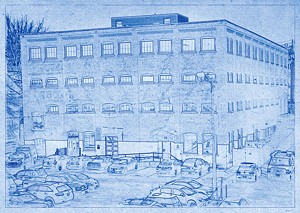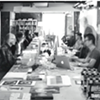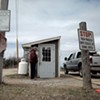Published November 20, 2013 at 12:55 p.m.
Even if you don’t know JDK, you know JDK. The Burlington design shop has shaped the looks of local darlings and global giants alike: Burton, Magic Hat, Seventh Generation, Merrell, Patagonia, Nike, Pepsi, Segway — all have been clients. And JDK’s creative minds are responsible for the look of Microsoft’s Xbox, including the hotly anticipated Xbox One that’s hitting markets this week.
Now the design firm is tackling a project closer to home: its own redesign.
Twenty-seven years after Michael Jager, Giovanna di Paola Jager and David Kemp teamed up, the Js and K are parting ways. All three partners are tight-lipped on the topic of the company’s apparent dissolution.
But change is openly afoot at 47 Maple Street, JDK’s longtime headquarters near Burlington’s waterfront. This fall, JDK has been shrinking its footprint there and rebranding the structure as the Karma Bird House, a co-working space intended for small businesses and independent workers in the creative economy that JDK helped to pioneer in the Queen City.
“This building is effectively the Karma Bird House,” Michael Jager, 54, told a crowd of roughly three dozen at a mixer in the JDK gallery earlier this month. He likened the converted workspace to a creative supercollider, the kind of place where a photographer could rub shoulders with a web developer, or an architect might strike up conversation with a renegade writer.
Two words flashed on a screen behind Jager, white against a green background: Hello. Hello.
“If you’re curious in life,” Jager said, the act of saying “hello” is a moment that can spark change. The Bird House, he said, is all about creating those moments.
But that “hello” for the Karma Bird House is “good-bye” for JDK, at least as it has existed in the past. The Bird House is filling up with a hodgepodge of creative, independent workers at a rapid clip. A tattoo studio on the second floor inked its first customer last week, down the hall from young game developers and techie types. Karma Bird House is home base for a photographer who recently relocated from New York, a filmmaker, an architect, writers.
But the reason there’s physical space at 47 Maple for these new simpatico ventures is that JDK — which at its largest employed 125 people in this building and is now down to roughly 30 — is shrinking and changing. Furniture from the design shop has been spotted at the nearby Office Furniture Exchange. Recent alums are listing new job titles at different companies on LinkedIn. Even at last week’s presentation, there were hints of change at the firm — such as the web developer who told the crowd, “I’ve worked with a lot of the people who used to work at JDK.”
The transformation is happening quickly, more than just the typical ebb and flow of business. Kemp declined to speak with Seven Days for this story; his two-line email response to inquiries read: “No, I am not available to be interviewed. I am no longer involved with JDK.”
That’s a monumental change. Again and again in interviews about JDK, former clients, friends and employees pointed to the partnership between Jager and Kemp as a main reason for JDK’s success. Their right brain/left brain pairing was primarily responsible for running the firm, especially after Giovanna Jager — a brilliant designer herself — stepped away from day-to-day business to raise the couple’s three children.
Alan Newman, the entrepreneur behind Magic Hat Brewing Company and Alchemy & Science, has known both Michael Jager and David Kemp for decades, since before JDK. Jager, who grew up in St. Albans, left for Montréal to attend design school; that’s where he met fellow student and Montréal native Giovanna di Paola.
The two returned to Vermont together. Jager developed a reputation in Burlington in the early and mid-1980s for doing excellent design work, but Newman says he didn’t have a mind for business. If a client complained that one of Jager’s designs was too expensive to produce, Newman says, Jager would occasionally subsidize the difference rather than compromise on his design.
That’s where Kemp, a New Yorker who’d relocated to Vermont, came in. “What David did was say, ‘Michael, the problem’s not you. The problem is your customer. You’re dealing with small Vermont customers that don’t have any money. We need to go get national accounts that can afford to do this shit.’” It’s when Kemp and Jager paired up, Newman says, that business began to take off. “When they got together, I went, ‘Oof, that’s a great combination.’”
And now?
“It will be totally different,” says Newman. “You can’t have JDK without either J or K. It’s back to the drawing board.”
Creative Alchemy, at All Hours
JDK’s original drawing board — almost three decades ago — was located in the basement of the Jagers’ then-home in Williston. It was three people with their noses to the grindstone, and one account in particular on which JDK would cut its teeth: Burton Snowboards.
“It was the most fortunate thing to possibly happen for everybody involved,” says Michael Jager now, reflecting on that partnership. Jager has the ropey look of an athlete — which makes sense, considering he bicycles to work every day of the year. His gray hair is close-cropped, and he wears the thick-rimmed glasses that are still shorthand for “hip.” He’s Burlington’s answer to Don Draper, if the “Mad Men” creative had ditched his cigarettes and booze for a bike and a snowboard.
In those early days, JDK and Burton were inventing snowboarding culture as much as they were dreaming up graphics and scheming over ad spots. Everyone — the JDK team and Burton reps alike — put in 20-hour days on the account. Jager says he’d go to sleep only to dream about snowboarding.
“It was a culture of invention,” he says. “Everybody was in it deeply.” Oh, and something else: “We didn’t know what we were doing.”
That turned out to be a strength; JDK wasn’t afraid to break the design and branding rules the Jagers and Kemp hadn’t yet learned. Their print ads were often unintelligible to those outside the burgeoning snowboarding subculture. They played fast and loose with Burton’s logo, changing it at will.
“Any conversation with Michael was always a conversation about possibility,” says David Schriber, who worked in Burton’s marketing department during the company’s early years. Jager was never satisfied with the status quo, says Schriber. “He would challenge us to reinvent — [it was about] the Ezra Pound ‘make it new’ idea.” Burton and JDK were “constantly sort of blowing things up and starting over in a new direction.”
Sometimes literally. In one ad spot, Jager and his team dragged a recliner up onto the mountain at Stowe, rigged it up with a MacGyver-style fuse, dowsed the chair with lighter fluid, and set it ablaze. The idea? Needle skiers to “get off [their] asses,” Jager says, and celebrate the emerging snowboarding culture that was all about being first on the lift and last off the mountain.
Schriber started as one of three people in Burton’s marketing department; by the time he left 11 years later, in 2003, he was a senior vice president. JDK remained Burton’s primary design agency throughout that time — working on everything from snowboarding graphics to product labels to advertising materials. (Now much of Burton’s design work is handled in-house, but as of this year JDK is still designing the graphics for about half of Burton’s snowboard line.)
Schriber says Jager brought more than just design chops to the table; Jager believed that “because they come from people, brands themselves are alive.”
And a living, breathing brand meant that, like an individual, a brand could grow and change and experiment. JDK wasn’t afraid to pitch ideas that, in retrospect, seem wildly divergent. Take a 1994 campaign JDK dreamed up: At a time when almost all of the major action sports brands were rooted in the culture of Southern California, JDK proposed that Burton play up its Vermont heritage. They recruited an elderly Vermont farmer to pose as a model for the company’s outerwear. They carted a foam deer target, the kind used by hunters for practice, to a photo shoot in France. When Burton went to a trade show in California, the Burton team took along a carpenter to construct an on-site post-and-beam barn, outfitted with antique braided rugs.
Then, a few years later, JDK suggested Burton upend that story. “Michael and his team came up with this idea of, ‘What would a snowboarding utopia look like in the future?’” says Schriber. The campaign mashed up Barbarella and 2001: A Space Odyssey; the catalog’s cover was stark white, and photographs showed riders wearing space helmets. In other words, as far from Vermont backwoods as it gets.
JDK’s Burton work was far from a moneymaker, at least for the first four or five years. According to a 2007 profile of the firm in Fast Company magazine, JDK was “hemorrhaging” $60,000 per year working for Burton, and counting on other clients to get by.
“They were a start-up and we were a start-up,” says Jager. And it didn’t matter that Burton was on a shoestring budget. “They were giving us a creative opportunity that was like nothing else in the world.”
JDK had a penchant for taking on passion projects — including Magic Hat: Newman says he didn’t have the money to hire the likes of JDK, so the principals took stock in the nascent brewing company in lieu of payment.
“Once they took the job, they never once tried to equate the value of the stock with the job,” says Newman. “They delivered probably two to three times what I was expecting.”
But the company was growing — out of the Jagers’ garage (Giovanna Jager says neighbors began complaining about FedEx trucks screeching in and out of the neighborhood), and then an office in the Kilburn and Gates Building in Burlington’s South End.
By 1995, when the three partners purchased 47 Maple for $715,000, JDK employed 55, according to a profile that year in this newspaper. (The building is still under the ownership of MDG, Inc., a corporation the three formed prior to acquiring the property. Today the building is valued at $2.2 million on city tax rolls.) JDK brought the Burton account to its new home, and that superstar client was joined by the likes of Converse, Specialized Bicycles and Merrell.
Newman says that when JDK helped him launch Magic Hat Brewing Company in 1994, “Those were the best days of my life. They were young. They were hungry. They loved the Magic Hat idea.”
Newman would wax poetic about the brand — which was all about bucking the conventions of what was then a homogenous craft-brew culture. “I’d come in a week later and see what they did with this garbage I spewed,” jokes Newman. The result? “Spectacular pieces of artwork.”
The default mode, at the Burlington warehouse, was one of long hours and uncomplaining hard work. “You’ve got to realize that it was a group of people who really thought that design could change the world,” says Chris Thompson, who worked at JDK for seven years, from 1993 to 2000; he started in IT and went on to start the firm’s film, video and interactive departments.
JDK’s work with Burton had caught the eye of young, up-and-coming designers; Thompson routinely had large stacks of portfolios on his desk sent from around the world. The firm was branding itself as a hip shop, willing to push boundaries and, by extension, gild careers. “It felt like a monastery, where everybody was so focused on what they were doing. Sometimes we just wouldn’t leave,” says Thompson.
If it seemed “a little cultish, from the outside looking in,” that was just appearances, says Malcolm Buick, a Scotsman who came to JDK by way of London in 1999. He went on to help launch the New York office in SoHo, which closed earlier this year; JDK still has an office in Portland, Ore. “Our heads were down, and we were doing stuff,” says Buick, who left JDK in 2004 to work at the larger international branding agency Wolff Olins.
“Doing stuff” meant everything from designing packaging to building brands from scratch; JDK, Fast Company wrote in 2007, “is a bizzarro creative hit squad that helps clients zero in on (and at times unearth) their psychographic id” — in parts ad agency, marketing guru and design genius. Today, the firm does some day-to-day design work for clients but is more often focused on the “heavy lifting” of launching a product or crafting a new brand.
When Jager talks about branding now, it’s with echoes of the early work he did for Burton. “We’ve dabbled with some ideas of ‘perpetual beta,’” says Jager. “It’s almost like you have to be so bold that you create a brand that’s almost constantly in beta form, so you never get too precious about everything. You’re willing to keep inventing.”
Xbox has done that brilliantly, Jager says. So has Seventh Generation. Is it fair to extend the idea to the new incarnation of JDK?
“Absolutely,” he says. “JDK is a design project. It is a living design project. And it has been many, many, many different things … and it’s because it’s been designed to adapt and shift and change in many and bold ways.”
Becoming More Corporate, and Less
Newman pulled back from the firm as both Magic Hat and the design company grew. That was largely because the brewery developed the in-house capacity to handle much of its design work. But it was also because the excitement of those early days had waned.
“They went after larger, more corporate accounts,” Newman says of JDK — and became, in his view, what they went after: larger and more corporate. When he returned to JDK for branding and design work on his current project, the craft-beer collaboration Alchemy & Science, Newman says he found a firm more structured and less freewheeling than the one he’d engaged almost 20 years prior.
And then, over the last year or so, Newman said his satisfaction with the firm took a hit. “We didn’t know what was going on behind the scenes, and all we were dealing with was our reality,” says Newman. Work was coming back slowly, and when it arrived, “we didn’t jump with excitement.” Prices were creeping up. Newman says he was on the brink of dropping JDK in favor of a new firm.
“There were days when — you get to go to Jager for a presentation? Boy, that lit up a whole day,” he says. “We had lost that enthusiasm.”
Jager agrees that JDK changed in those years. Newman, he says, “really understands that there was a lot of dynamic change happening, both in the economy and in our [company] culture. We were working through some things. It’s understandable.”
When the company was at its biggest, Michael Jager says he didn’t know the names of some of the 125 employees he’d pass in the hall — a feeling he hated.
“It was way too big, and did not work, and was not a smart model,” says Jager. “We definitely got to the point where it wasn’t fun … We touched that flame of scale, and it just didn’t feel right.”
The recession that began in 2008 played a role in the downsizing that was to come, Jager says. Today the company employs about 30 in the Burlington office and 12 in Portland. Will it stay that size? Jager won’t say. He also won’t say when and how many layoffs have taken place in recent months — but acknowledges the last four or five have been tumultuous.
But it wasn’t just economic woes that led to JDK scaling back.
Around September, Newman received a call from Jager. He told Newman that his relationship with Kemp had deteriorated and the two were going their separate ways. The vision as Jager painted it was one of a decentralized studio, with less overhead and more flexibility.
“I think that’s a strategy that can work,” says Newman. “You bring down your overheads, and all of a sudden the world’s a little bit different.”
Now Newman — who declares, “You’re not going to find a bigger Michael Jager fan” — is eager to see what comes next. He says he’d hire Jager again “in a heartbeat” if he has a project that makes sense. And he’s hopeful that a smaller JDK will mean more access to the designer himself — and, potentially, the return of the excitement of JDK’s early days.
Trying for the Right Size
The “make it new” axiom is so ingrained in JDK thinking that two current employees, Christine Dodson and Sascha Mayer, bring it up unprompted in a separate conversation.
So does Michael Jager, during an interview in JDK’s rooftop conference room. The room lacks the urban, industrial-chic flair of the rest of the office. Here it’s all white walls and black office chairs — and a spectacular view of Burlington’s waterfront. Michael and Giovanna Jager settle into swiveling chairs opposite the panoramic vista. Giovanna, dressed all in black, is back on the job after a 12-year break.
What will it mean to create a new design firm, a new name? While the Jagers are happy to reflect on design culture, reminisce about JDK’s early days and talk branding strategy, their lips are sealed about the future.
“We did a lot of wonderful things together that I think we should be proud of,” says Michael Jager, when asked about JDK’s fractured partnership. But ask for specifics — Did Kemp buy out of the business? Under what circumstances did he leave? — and Jager goes mum. He shrugs slightly. “The alignment just wasn’t there anymore.”
Meanwhile, several former employees declined to speak on the record to Seven Days about recent changes. It’s not out of character for the company; the nature of JDK’s work with clients, particularly on products or brands still a long way from the market, meant secrecy was part and parcel of doing business. When JDK landed the Segway account, for instance, designers constructed canvas tents around their desks to keep other coworkers in the dark.
Several of those former employees said they didn’t want to burn bridges at the firm, which, though diminished in size, remains a major player in Burlington’s design scene.
JDK may be a leaner operation these days, but its building, a hulking 45,000-square-foot brick warehouse, is bustling. The Karma Bird House is in keeping with a new strategy JDK has undertaken in recent years to incubate design projects within the company. Maglianero Café — where the cause célèbre is commuter-cycling culture — is one of those projects. So is Mamava, a project that JDK’s directors of brand strategy and accounts, Mayer and Dodson, are heading up to devise design solutions for breast-feeding mothers. The goal behind all three enterprises is to control design from concept to execution.
Such cause-driven projects have launched JDK into the world of entrepreneurism — an unusual choice for a design firm. JDK set up a separate company to incubate these fledgling businesses and shares in ownership of various projects with different partners.
As entrepreneurial ideas go, the Karma Bird House has been an early success. The entire second floor is full, and renters are rapidly moving into the third floor — a space where JDK’s secretive design work is still barricaded from view of visitors. Rent in the building ranges from $300 per month for the smallest office to $1500.
The tenants are mostly members of what Lars Hasselblad Torres, director of Vermont’s Office of the Creative Economy, calls the independent workforce; some studies say these individuals could make up 50 percent of U.S. workers as early as 2015.
Torres points to one former JDK employee — designer Craig Winslow, who left in May but keeps an office at Karma Bird House — as an example.
“People like Craig Winslow are moving out of the company but staying in the shoebox,” says Torres. “JDK has the head of Craig at their disposal, but without the overhead.”
For his part, Winslow gets to pursue his own personal and artistic projects, Torres continues, while being able to tap JDK for guidance. “That kind of nimbleness … is really a hallmark of the independent workforce.”
Giovanna Jager is the go-to for all things Karma Bird House; she presides over operations here from a tiny office on the second floor. On a recent circuit through the building, Jager, in black skinny jeans and stylish wedge boots, seems very much in her element; she greets tenants by name, and fluffs pillows in one of the shared lounge spaces.
“When it was an option either to sell [the building] or keep it, I could not fathom not having this building,” she says. From the design studios to the café, from the gallery to nonprofit Iskra Print Collective, “it has grown into much more than just bricks and mortar. It’s an organism. I just love what is happening inside these walls.”
The building is all exposed brick and high ceilings. There were holes in the roof and pigeons roosting in the rafters when Giovanna, with baby in arms, strolled through the building in 1995. For nearly two decades, 47 Maple was JDK’s fortress, with a few public exceptions. The gallery space on the building’s first floor, originally known as the Exquisite Corpse, has hosted cutting-edge art shows over the years. And JDK further engaged the public in 2011 with the unveiling of Maglianero. Michael Jager says JDK designed the café as a subterranean “anti-Starbucks.” Tucked away out of view from the street, it’s still unknown to many Burlingtonians. He hopes that will change when Maglianero moves upstairs, next month, to a street-level space.
Though JDK is welcoming new tenants, the Jagers still hold close to some of their secrets. The only thing Michael Jager will say about the future of JDK Design is that there will be news in the new year.
“The plan is about focus, and intelligent focus,” he says. The scaled-back JDK is being remade with an eye toward “bespoke” design. Rather than maintain a large studio, Jager might assemble teams as needed for various projects. He says he’ll play a more hands-on role in design work than he did when the firm was at its largest.
The pared-down model is one that many in the design industry — as well as independent, creative entrepreneurs — say makes more sense than large, expensive firms.
“Studios are becoming smaller and more nimble ... You need to be able to react to that environment, and when you’re a bigger machine, it’s hard to flex and move and be scrappy,” says former JDK employee Malcolm Buick. “When you look at the industry in general in the U.S., there is this start-up mentality,” he says. “There is this idea of, ‘Fuck it, I’m going to do it myself.’”
Does it mean a return to the JDK days of yore, when the small start-up threw itself headlong into radically unconventional work?
Michael Jager won’t go that far. “Nostalgia is truly no good,” he says. “You have to be very focused on the future, and the future is going to be pure and uncut. The energy is going to be radical, but it’s not going to be the energy that is 25 years old.”
The original print version of this article was headlined "JDK (re)Design"
More By This Author
About the Artist

Matthew Thorsen
Bio:
Matthew Thorsen was a photographer for Seven Days 1995-2018. Read all about his life and work here.
Matthew Thorsen was a photographer for Seven Days 1995-2018. Read all about his life and work here.
Speaking of...
-

Q&A: Catching Up With the Champlain Valley Quilt Guild
Apr 10, 2024 -

Video: The Champlain Valley Quilt Guild Prepares for Its Biennial Quilt Show
Apr 4, 2024 -

Q&A: Meet a Family in Waterbury That Embraces Halloween Year-Round
Feb 14, 2024 -

Video: Goth Family in Waterbury: Sarah, Jay and Zarek Vogelsang-Card
Feb 8, 2024 -

Q&A: Art Entrepreneurs Tessa and Torrey Valyou Celebrate 15 Years of New Duds
Oct 11, 2023 - More »
Comments
Comments are closed.
From 2014-2020, Seven Days allowed readers to comment on all stories posted on our website. While we've appreciated the suggestions and insights, right now Seven Days is prioritizing our core mission — producing high-quality, responsible local journalism — over moderating online debates between readers.
To criticize, correct or praise our reporting, please send us a letter to the editor or send us a tip. We’ll check it out and report the results.
Online comments may return when we have better tech tools for managing them. Thanks for reading.


















































